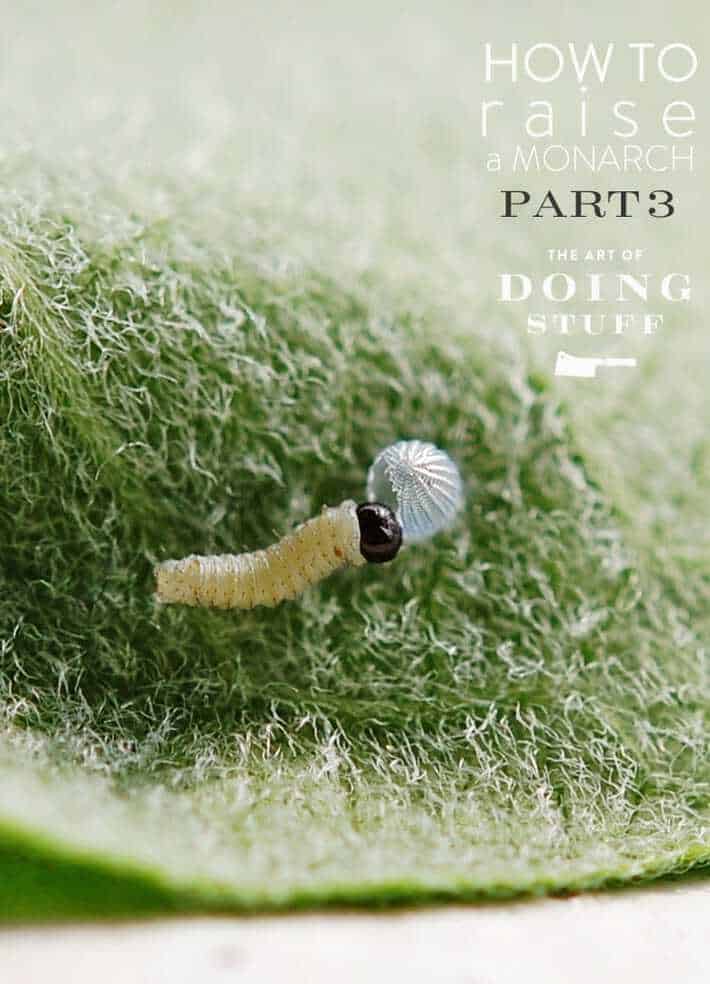
How to Raise a Monarch
Have you read How to Raise a Monarch Butterfly Part 1 and also Part 2? 'Cause you need to read those first. If you *have* read parts 1 and 2 that means you have gone looking for some milkweed and eggs. Got em? Good. Now we can continue.
For those of you finding this post last in the summer: If you don't have your eggs yet, you have until September or October to find some. Monarchs lay their eggs until that time. And here's the fun part! Regular old summer Monarchs only live for a few weeks. The group of Monarchs that are born last ... around September or October ... are the ones that migrate to California and Mexico!
Days 1-5 in raising your Monarch butterfly pretty much involve staring at an egg. I can save you a bit of staring time by letting you know that a telltale sign it's about to hatch is the fact that the egg goes clear and the tip turns black. This black tip is actually the caterpillar's head that you can now see inside. Raising Monarchs is all kinds of freaky from beginning to end.
Once you see the black head of the caterpillar through the shell, keep your eye on it. It means todays' the day you're going to have to start taking care of something.
Not about to hatch:
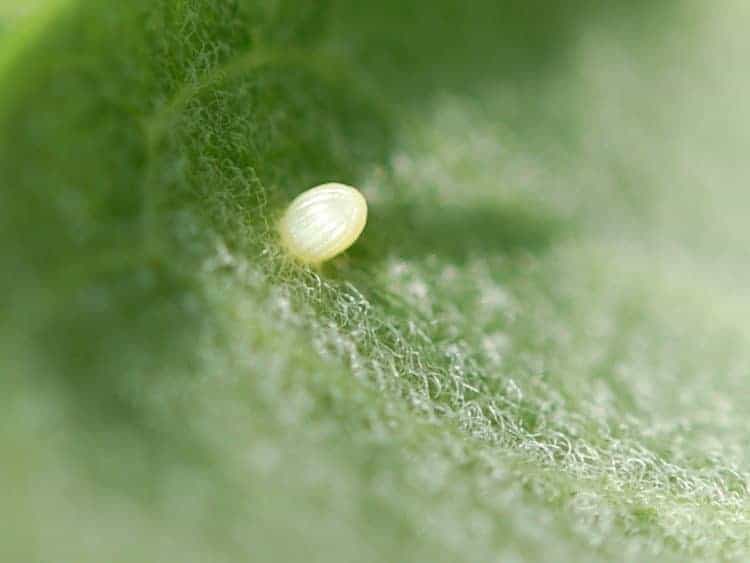
Totally about to hatch:

Chances are you aren't going to see the caterpillar emerge. So for you, I sat around for 5 hours with a supply of snacks and a camera.
After several hours the caterpillar pushes itself out of the egg.
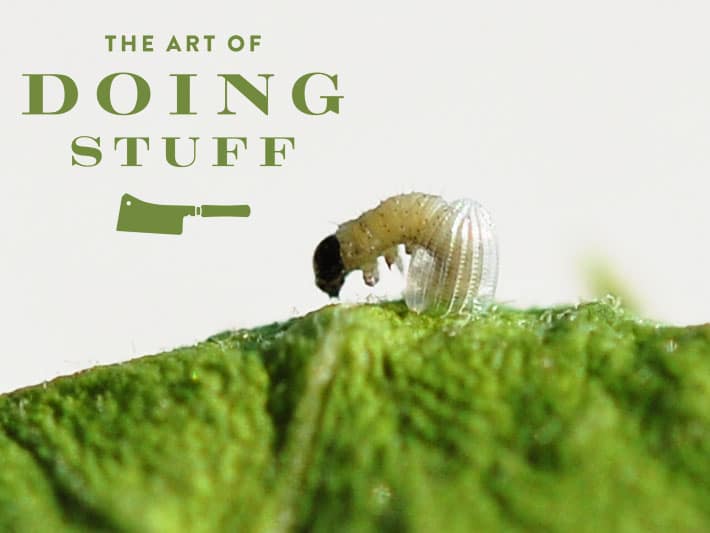
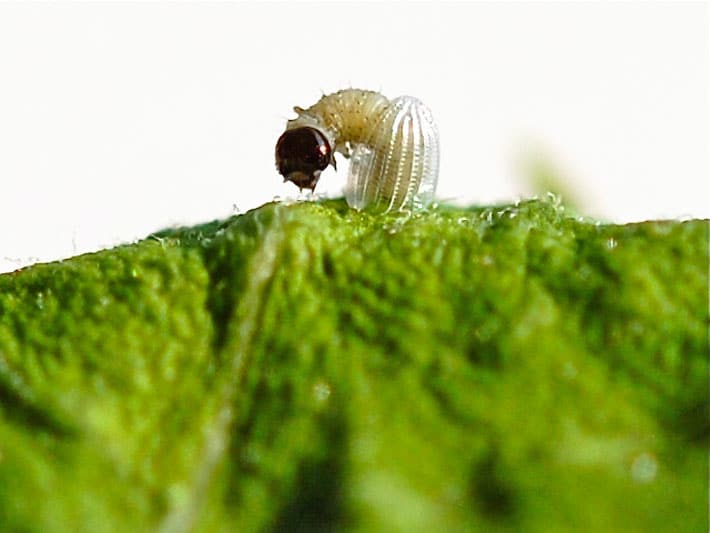
He'll go for a little walk. (the first of many)
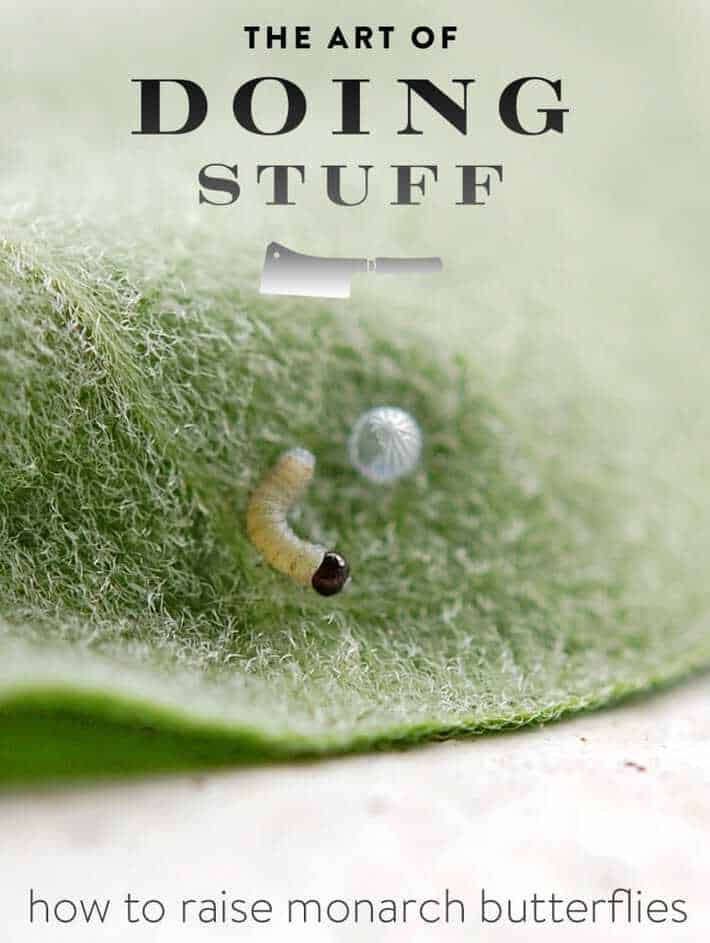
And then he'll come back and have his very first meal. His shell.
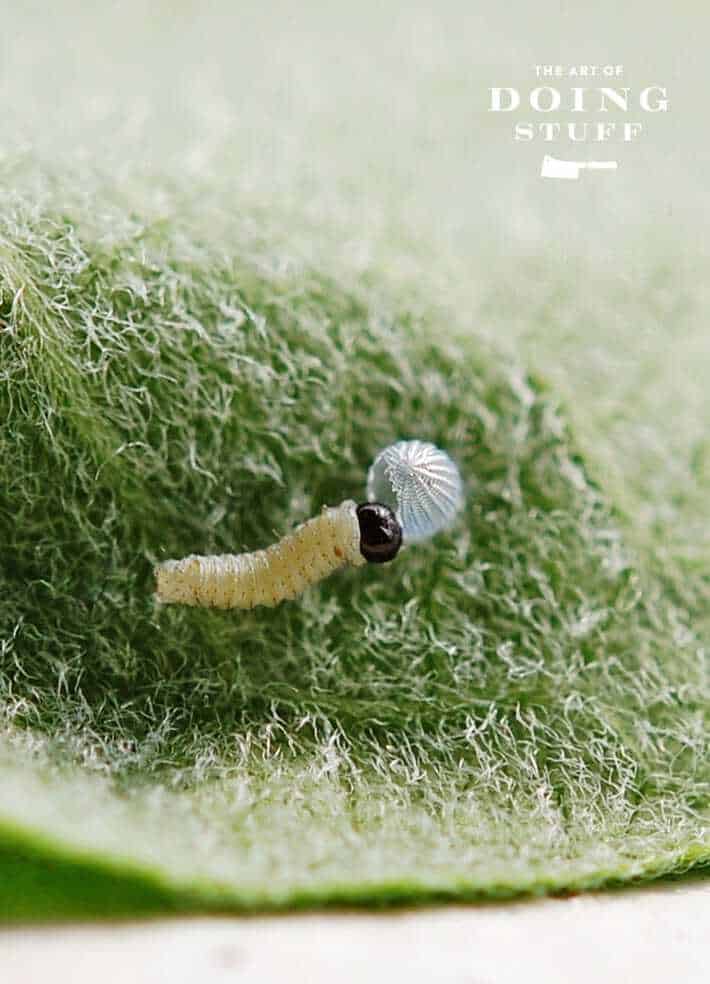
Even better? I got it all on video.
O.K. You've birthed a caterpillar! Now what?
Days 5-8
Put your caterpillar in the nice little house you made for it.
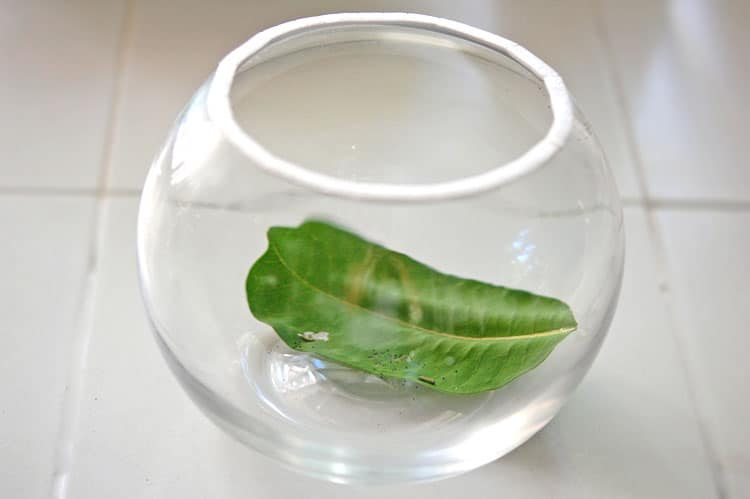
For the rest of its life you have to make sure the caterpillar has fresh milkweed leaves. Not dried up, crispy leaves. Once you see the leaf is getting to look old, replace it with a fresh one. The caterpillar eats non-stop when it's in its growing phase. If it doesn't have fresh food it will die. And you will be a murderer.
You also have to clean up after the caterpillar. That means you have to clean the poo out of its house. If the caterpillar is on the leaf, just gently pick up the leaf and tap it. The poo on the leaf will fall off, but the caterpillar will stay on. They have tremendously strong feet those caterpillars. Also wipe any poo out of the bowl.
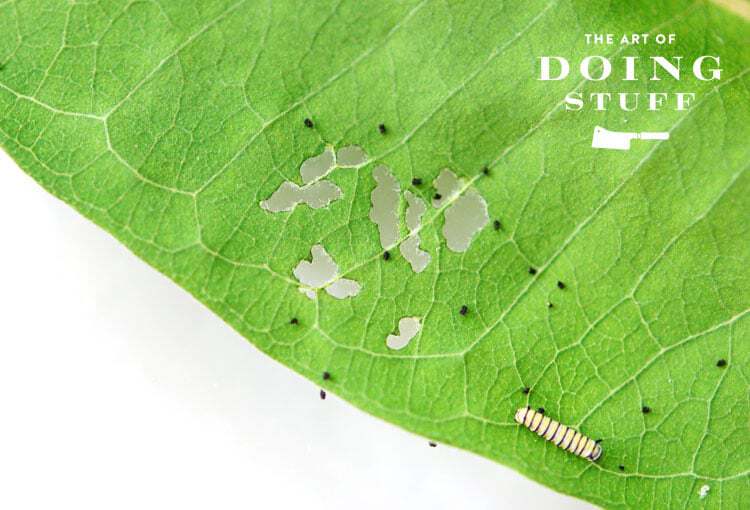
A 2 day old Monarch caterpillar and its poop.
When your caterpillar is 1-4 days old you're gonna have a couple of problems. For starters the caterpillar is almost impossible to see and you're going to be convinced it's gone. It isn't. Unless it is. For some reason the baby caterpillars want to escape their perfect little homes. And they will go on walkabout. THAT is why I tell you to use the two way tape and screening on top of your bowl.
This particular caterpillar was making its way up to the top of the bowl to try and escape. Yours will try to do the same.
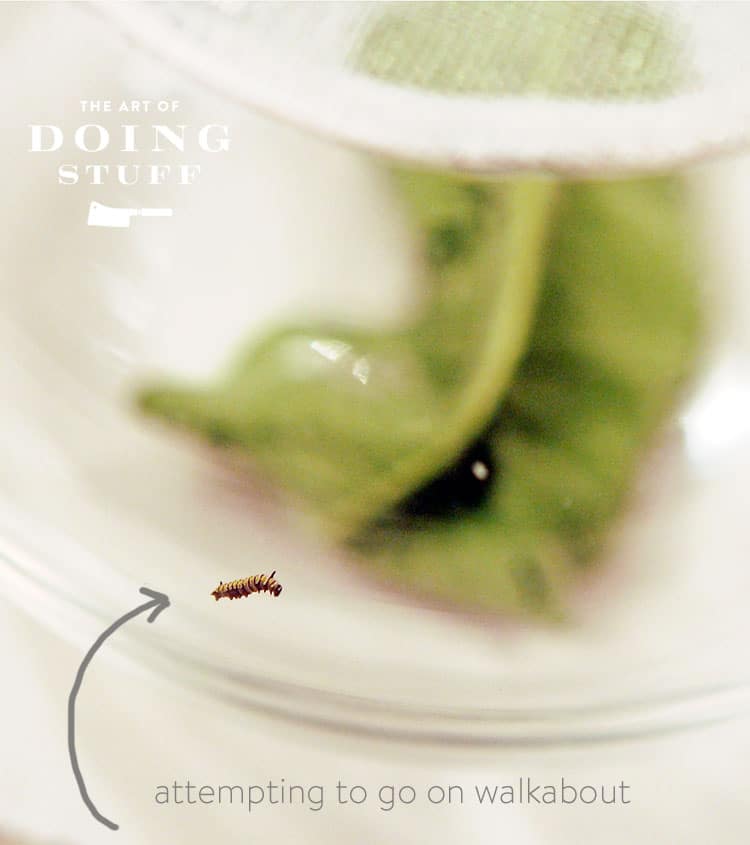
Would you like to save this stuff?
If you manage to keep track of your caterpillar for the first few days, the rest is a breeze.
Days 8-14
Just keep giving it fresh milkweed and cleaning out the poo and it will grow and grow and grow. And poo and poo and poo.
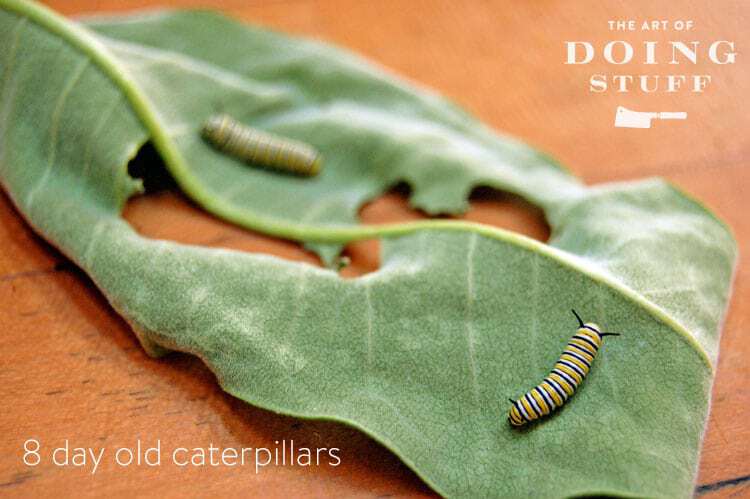
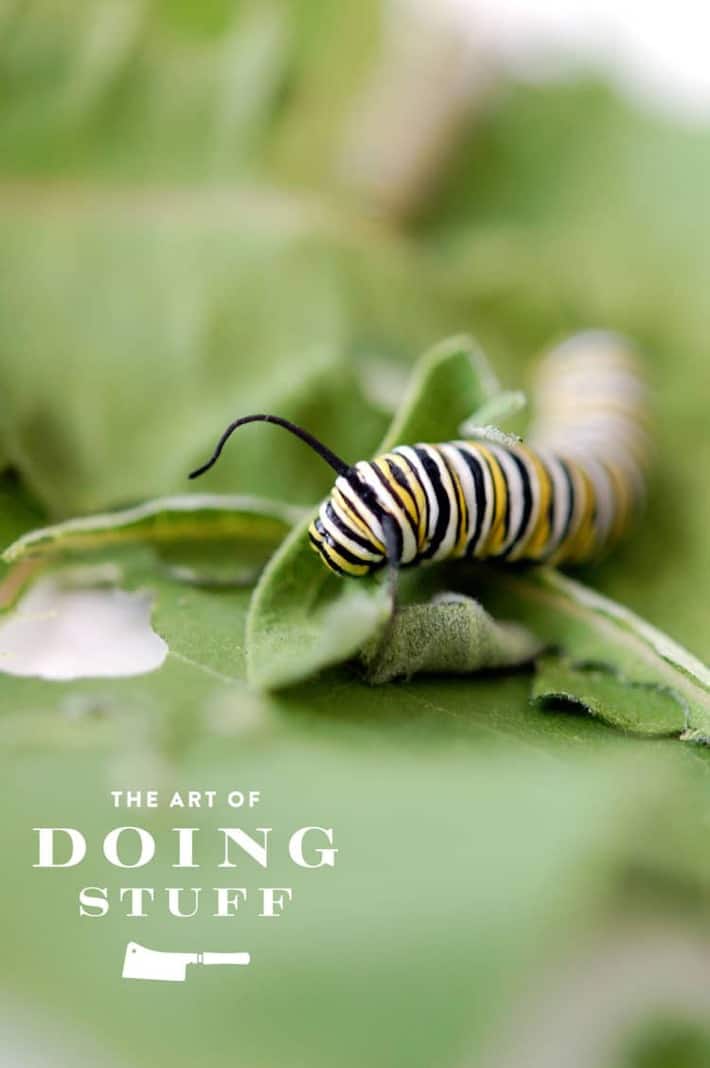
The Monarch caterpillar has 5 instars. That means it sheds its skin 5 times. Each time it sheds its skin it emerges a bigger, brighter version of itself. You'll know when it's about to shed its skin because it stays still for HOURS. It doesn't eat, it doesn't move, it just lays there. You'll think it's dead. It's not. Remember ... it does this "playing dead" thing 5 times. It's kind of like a hibernation.
This is the final skin shedding for this caterpillar.
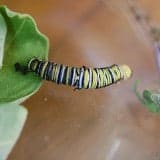
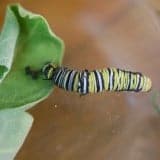
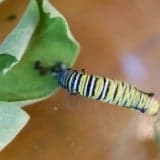
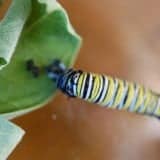
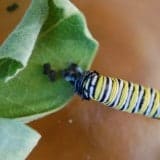
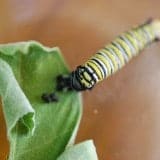

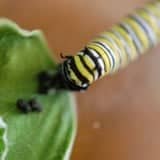
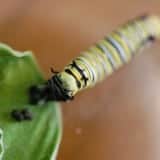
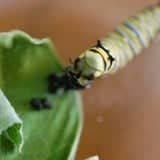
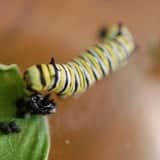
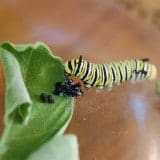
Notice how squashed down its new antennae are.
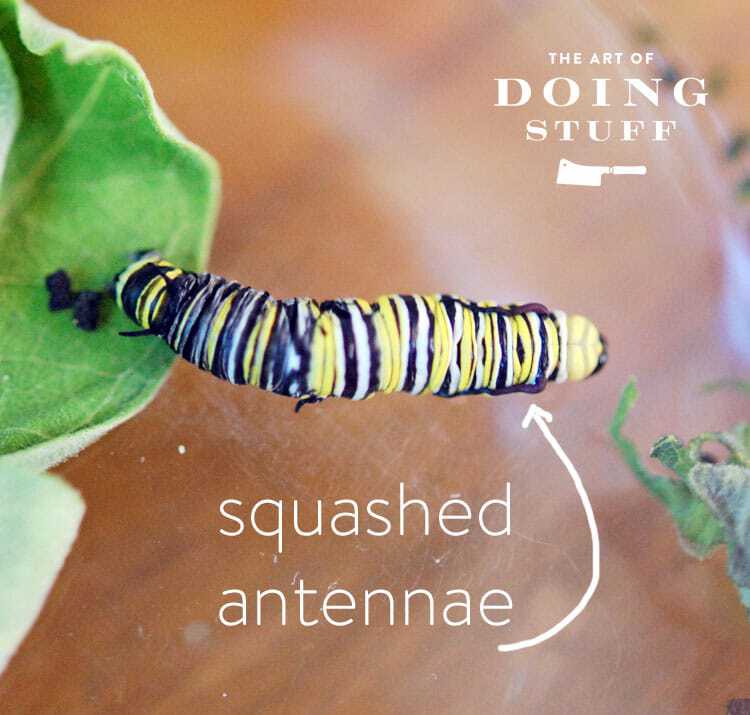
This final caterpillar stage will last a couple of days. Keep feeding it. In return, out of love and kindness, it'll keep pooping.
A day or so after the caterpillar sheds its final skin it'll start wandering again. It'll probably make its way up the sides of your bowl and crawl around on the screen for a while. It may even take a bit of a nap there. It's picking out its final resting place. Then it'll probably wander back down again, snack for another half day or so, then wander back up onto the screen.
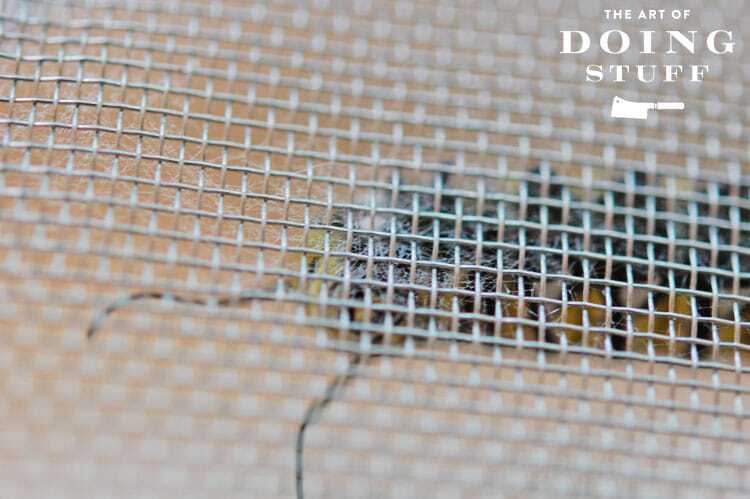
Once the caterpillar realizes life would be much better as a butterfly - what with the ability to fly and all - it crawls up onto the screen and starts spinning a cotton-like thread out of its mouth.
Then the caterpillar will turn around and stick its bum into the miniature cotton ball it's made.
Over the course of a couple of hours the caterpillar will loosen it's grip on the screen. One by one, leg by leg it'll let go.
Until it drops down, held only by its bum, into a "J" shape. Or a "6". Depending on which side you're lookin' at of course.
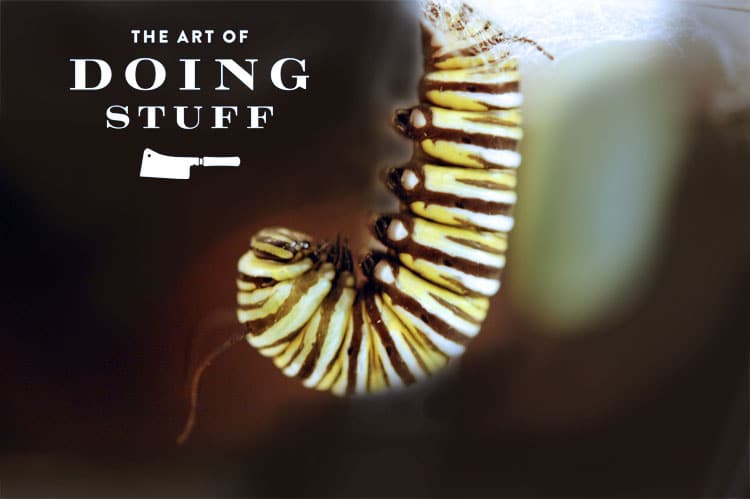
And this folks ... is where it starts to go all science fiction on us ...
Coming up tomorrow things start to get WEIRD. In Part IV

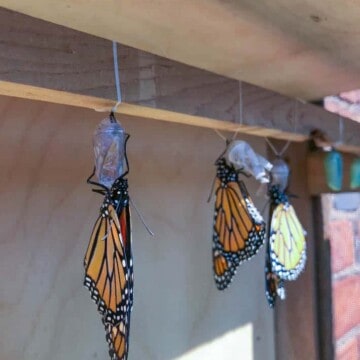
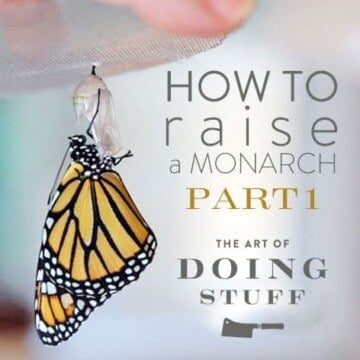
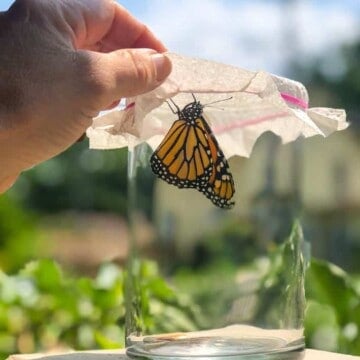
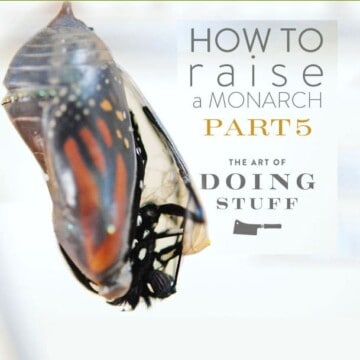
Melissa White
Hello Karen, what date do I start looking for monarch eggs in Michigan? Last year was my first. I released over 25 butterflies!!
Karen
Hi Melissa. Once you see a Monarch flying around. They tend to arrive once the milkweed has sprouted and started growing. :) ~ karen!
Jennifer
Is there a blog post Pulitzer? OMG.
Beth
I just went egg hunting in one of our fields. Luckily we have one that hasn't been hayed, yet. I found three eggs and a teeny tiny caterpillar. The caterpillar looks a bit different, so I'm wondering if it is, in fact, a monarch. Guess I will find out. I used large Mason jars so I could hold the screen on with the jar ring. I also put them on my screened-in back porch. I'm excited to try this. We do have quite a few monarchs here in our fields. Now I just have to keep our friend from mowing down the milkweed when he hays the field. I would like to propagate some to grow closer to our house.
Funnybones
What the heck does Pupate mean I think when a Butterfly is ready to Pupate it just lifts up it's leg and goes Lol. My teacher says in the Winter Butterfly s look for warm places to stay so I think better keep my belt on so one doesn't fly into my butt crack. Thanks.
Cheryl Peters
The clear glass bowl you use. How big is it?
whitequeen96
Karen, thank you SO much for taking the time to make the video of the caterpillar hatching! It really is awe-inspiring. I think you've established your credentials as a Monarch butterfly researcher, and the world is definitely a better place because of you!
Karen
:) Thanks and glad to help! ~ karen
Scout
I realize you may have been raising Monarchs longer than I have, but i wondered if you would like some updates on both vocabulary and research. I don't want to assume you do. So let me know.
I will tell you my favorite swear word now~~ Frass! That's caterpillar poo...comes in handy. Like "Well, he's a frassy one!"
"Oh Frass! That one is missing again!"
And those hairs on the leaves that you have so beautifully captured? They are call trichomes. They are one of the plants arsenal in the 'Arms Race" between the caterpillars and the plant. That little tiny caterpillar first has to 'mow' (or eat down) those trichomes (hairs) in order to get to the meat of its meal...the leaf. No nutrients in trichomes, and it can take an hour or so. Each time a caterpillar starts to eat a new area of a leaf, they have to mow down the trichomes first to get to the leaf.
So many interesting things to learn!
Shawna
One of my six didn't make it. :( Itwasjust as he was getting quite large. Here is hoping the other 5 pull through.
Heather
I enjoyed your nature video. : )
TucsonPatty
It makes me so sad they are disappearing. I loved seeing them when I was growing up, in Kansas, with that dreaded sticky Milkweed plant that we had to clean out of the wheat fields.
One of my daughters first Halloween costumes was a Monarch Butterfly. It was a very ambitious handmade costume, having wings that also belonged to a Fairy Princess in yet another year. Thank you Karen, for continuing to remind us of the plight of the Monarch. Are your statistics of the population declining 90% still holding true? We are not being very kind to Mother Earth right now.
Paula
Mine is a little wee worm type thing now :) I am very pleased.
Jan in Waterdown
The video is brillyunt! Even if it did make me need/want to pee a LOT in the part before the music. I hope that was a water feature trickling and not something "else"...
And your choice of music was inspired. I hope Ellen was watching. That made lol!
Heather (mtl)
Nature is soo freekin amazing! Breathtaking, actually.
A few years ago, I had a summer of monarchs. So beautiful and quite rare, It seems each year we have a bug of the year (dragonflies are back) and for the first time in ages, this year I see grasshoppers. A nice break as the last 2 years also found me carrying one-by-one all the lady bugs that followed me home (I counted 14 trips to my balconey one evening alone).
Heaps better than those scarey Spiderwasps. I don't touch that!
I wish I knew where the milkweed was around here. Must be nearby if I had some monarchs.... no?
Jenifer
This is so freakin' cool!!! Still looking for my eggs... :)
Linda in Illinois
I bought several milkweed plants this year at a show just for this purpose. I have wild milkweed in the field across the street, I must go see if there are any eggs and begin the process. I would enjoy this very much. Thank you for all the info, I had no idea.
Donna
Love your posts! and this was very interesting!
This is totally off the subject, but I've often wondered if you have hummingbirds...I don't see feeders in any of your outdoor photos.
Karen
There are hummingbirds in my area but I've only ever seen a few at my house in the past several years. It was when I had a huge trumpet vine in the side of my yard. I'm sure if I put up a feeder I could attract them. Maybe I'll give it a shot. ;) ~ karen
mia pratt
Everyone knows the golden threads are where the faeries sewed up the little green castle, where the butterfly will be born....just sayin'.
Cheryl Peters
I like your explanation.
Teresa
Yeah, duh!
Cynthia Jones
I looked up the gold spots on the chrysalis and found this website.
https://www.learner.org/jnorth/tm/monarch/ExpertAnswer10.html
Q: On the crysalis at the lower edge of the top region is a ring of gold dots. Of what substance are these composed? Do they have any special function?
A: Fred Urquhart first studied the gold spots on monarchs in the 1970s. He felt that the spots were involved in the distribution or formation wing scale coloration. However, the experiments that he did involved cauterizing the gold spots on the pupa, and it is possible that this process may have damaged the underlying tissue and affected the color patterns. Interestingly, all /danaine/ butterflies (monarchs and their relatives) have metallic spots on them. A group of researchers in Germany did a careful study of the properties of these spots. They are not metallic (so they aren't really gold), but the cells reflect light like metals do, giving them the appearance of being metallic. Other danaids have silver, copper, or gold spots.
Here are some hypotheses for the reasons that these butterflies have metallic-looking spots on their pupae:
a) camouflage they could reflect colors of the surroundings and break up the shape of the pupa; they might also look like dew droplets.
b) Warning coloration
c) Filtering particular wavelengths of light which might be harmful to the monarchs
d) They might not have any function, but just be the result of something else in the cuticle of the insect.
whitequeen96
Thank you for this info! I was wondering about this.